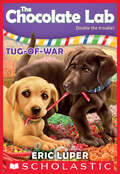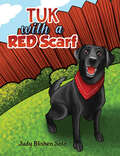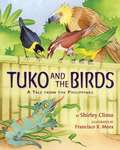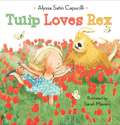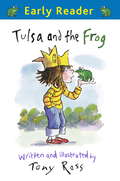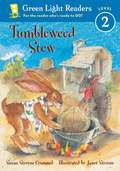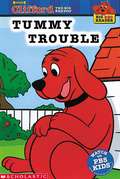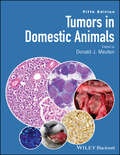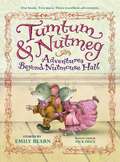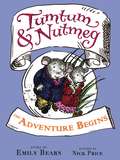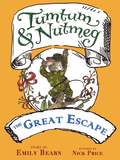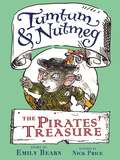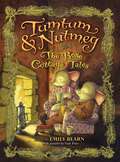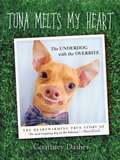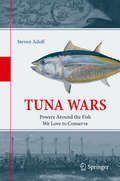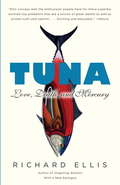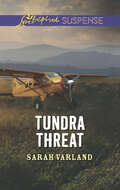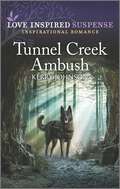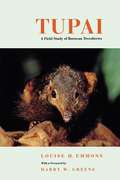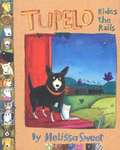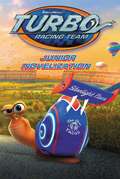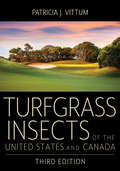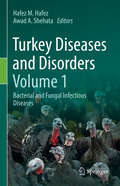- Table View
- List View
Tug-of-War (The Chocolate Lab #2)
by Eric LuperOne candy-crazed Labrador plus one feisty puppy equals double the trouble in this irresistible chapter book series from the author of The Chocolate Lab.When Mason and Hannah find a tiny yellow Labrador named Nilla out by the old mill, Hannah is dying to keep her. But Mason isn’t sure that’s a good idea. Not when they are busy trying to turn the mill into a chocolate factory to save the family’s business. Plus the Cabots already have a dog, and Cocoa’s wild ways are always stirring up trouble. Adding an untrained, rowdy puppy to the mix might just be a recipe for disaster!
Tuk with a Red Scarf
by Judy Blishen SotoDive into a heartwarming journey of miracles, divine twists, and a dash of luck in this captivating tale. Meet Tuk, a charming black Labrador adorned with a red scarf, whose simple act of curiosity sets the stage for an extraordinary adventure when he wanders off through an open gate. Left behind is the irritable Scottish Terrier, Scotty, unwittingly embarking on a chain of events that intertwine fates and unveil the tender magic of serendipity. From mistaken identities to life-saving encounters, discover how a single inadvertent moment can unfurl a tapestry of heartening tales. Tuk with a Red Scarf is a true story which celebrates the unassuming yet profound impacts of everyday actions, promising to keep you enchanted till the last page.
Tuko and the Birds: A Tale from the Philippines
by Shirley ClimoWhen Tuko the gecko cries so loudly that the birds stop singing and cannot sleep, they try to trick him into moving from their home on the Philippine island of Luzon.
Tulip Loves Rex (Tulip and Rex)
by Alyssa Satin Capucilli Sarah MassiniAlyssa Satin Capucilli, beloved author of the bestselling Biscuit books, has written another charming story about a little girl and her dog. With illustrator Sarah Massini's whimsical artwork, Tulip Loves Rex is perfect for fans of Ladybug Girl by David Soman and Jacky Davis and A Pet for Petunia by Paul Schmid. <p><p> Tulip Loves Rex is a sweet story about Tulip, who loves to dance, and her new friend Rex, a fluffy dog who also loves to dance. The lyrical text touches on themes of friendship, acceptance, and, most important, finding out what makes you who you are—and sharing that with someone you love. <p><p> This lively but gentle story is perfect for bedtime and for any child who dances through life or dreams of having a pet as a best friend.
Tulsa and the Frog
by Tony RossEarly Readers are stepping stones from picture books to reading books. A blue Early Reader is perfect for sharing and reading together. A red Early Reader is the next step on your reading journey.Tulsa dreams of a life as exciting as the girls in her story books. First she tries pretending to be Snow White, Pippi Longstocking and Rapunzel. Then one day, in an enchanted forest behind her house, she discovers a talking frog...
Tulsa and the Frog (Early Reader)
by Tony RossEarly Readers are stepping stones from picture books to reading books. A blue Early Reader is perfect for sharing and reading together. A red Early Reader is the next step on your reading journey.Tulsa dreams of a life as exciting as the girls in her story books. First she tries pretending to be Snow White, Pippi Longstocking and Rapunzel. Then one day, in an enchanted forest behind her house, she discovers a talking frog...
Tumbleweed Stew (Green Light Readers)
by Janet Stevens Susan Stevens CrummelJack Rabbit says it's a great day to make tumbleweed stew, but who wants to eat that? With a bit of ingenuity, Jack soon has everyone from Armadillo to Vulture adding something to his delectable stew.
Tummy Trouble
by Ken Edwards Kimberly Weinberger Josephine PageClifford, Cleo and T-Bone decide to give themselves treats for doing tricks. Now three crates of treats are empty and there's tummy trouble all around.
Tumors in Domestic Animals
by Donald J. MeutenTumors in Domestic Animals, Fifth Edition is a fully revised new edition of the most comprehensive and authoritative reference on veterinary tumor pathology in common domestic animals, now in full color throughout with the most current advances in research and diagnostics. Now in full color with hundreds of exquisite new images showing diagnostic features, pathogenesis, and techniques Adds new sections on relevant clinical pathology and oncology Updated throughout to include the very latest advances in research and diagnostics Takes a logical, user-friendly system approach Written by leading experts on animal tumor pathology
Tumtum & Nutmeg: Adventures Beyond Nutmouse Hall (Tumtum & Nutmeg #1)
by Emily Bearn Nick PriceDeep inside the broom cupboard of Rose Cottage, two mice live in great style. Tumtum and Nutmeg lead cozy and quiet lives, secretly looking after Arthur and Lucy, the disheveled human children of the cottage, never dreaming that so many exciting adventures will soon find them. But when evil Aunt Ivy, a squeamish schoolteacher named Miss Short, and pirating pond rats threaten the safety of those they hold dear, the courageous pair will stop at nothing to save the day. In three thrilling tales with charming illustrations in every chapter, Tumtum and Nutmeg--along with the valiant efforts of veteran hero General Marchmouse, Ms. Tiptoe's bouncing ballerina army, and a team of caged gerbils--prove that small-size mice can have world-size hearts.
Tumtum & Nutmeg: The Adventure Begins (Tumtum & Nutmeg #1)
by Emily Bearn Nick PriceTumtum & Nutmeg: The Adventure Begins is the first of three short stories from Tumtum & Nutmeg: Adventures Beyond Nutmouse Hall. Tumtum and Nutmeg lead cozy and quiet lives, secretly looking after Arthur and Lucy, the disheveled human children of Rose Cottage, never dreaming that so many exciting adventures will soon find them. But when evil Aunt Ivy, a squeamish schoolteacher named Miss Short, and pirating pond rats threaten the safety of those they hold dear, the courageous pair will stop at nothing to save the day. In this thrilling tale of daring and wit, Tumtum and Nutmeg -- along with veteran hero General Marchmouse, Ms. Tiptoe's bouncing ballerina army, and a team of caged gerbils -- prove that small mice can have big hearts.
Tumtum & Nutmeg: The Great Escape (Tumtum & Nutmeg #1)
by Emily Bearn Nick PriceTumtum & Nutmeg: The Great Escape is the second of three short stories from Tumtum & Nutmeg: Adventures Beyond Nutmouse Hall. Tumtum and Nutmeg lead cozy and quiet lives, secretly looking after Arthur and Lucy, the disheveled human children of Rose Cottage, never dreaming that so many exciting adventures will soon find them. But when evil Aunt Ivy, a squeamish schoolteacher named Miss Short, and pirating pond rats threaten the safety of those they hold dear, the courageous pair will stop at nothing to save the day. In this thrilling tale of daring and wit, Tumtum and Nutmeg -- along with veteran hero General Marchmouse, Ms. Tiptoe's bouncing ballerina army, and a team of caged gerbils -- prove that small mice can have big hearts.
Tumtum & Nutmeg: The Pirates' Treasure (Tumtum & Nutmeg #1)
by Emily Bearn Nick PriceTumtum & Nutmeg: The Pirates' Treasure is the third of three short stories from Tumtum & Nutmeg: Adventures Beyond Nutmouse Hall. Tumtum and Nutmeg lead cozy and quiet lives, secretly looking after Arthur and Lucy, the disheveled human children of Rose Cottage, never dreaming that so many exciting adventures will soon find them. But when evil Aunt Ivy, a squeamish schoolteacher named Miss Short, and pirating pond rats threaten the safety of those they hold dear, the courageous pair will stop at nothing to save the day. In this thrilling tale of daring and wit, Tumtum and Nutmeg -- along with veteran hero General Marchmouse, Ms. Tiptoe's bouncing ballerina army, and a team of caged gerbils -- prove that small mice can have big hearts.
Tumtum & Nutmeg: The Rose Cottage Tales (Tumtum & Nutmeg #2)
by Emily BearnDeep inside the broom cupboard of Rose Cottage, two mice live in great style. Tumtum and Nutmeg lead cozy and quiet lives, secretly looking after Arthur and Lucy, the disheveled human children of the cottage, never dreaming that so many exciting adventures will soon find them. But when evil Aunt Ivy, a squeamish schoolteacher named Miss Short, and pirating pond rats threaten the safety of those they hold dear, the courageous pair will stop at nothing to save the day.
Tuna Melts My Heart: The Underdog with the Overbite
by Courtney DasherTuna’s cartoonish looks—with an exaggerated overbite, a recessed jawline, and a wrinkly neck—are truly one of a kind. And yet his quirky appearance is no match for his unique perspective on life, overcoming his proclivity for staying in bed all day to keep his eye on the (bacon-flavored) prize. <P><P> Teaming up with his owner, Courtney Dasher, Tuna shares a behind-the-scenes look at his daily exploits, which include sleeping, sunbathing, wearing bow ties, playing with toys, and melting hearts. <P> Packed with witty and endearing images of this ridiculously adorable pup, Tuna Melts My Heart is sure to delight the underdogs in us all!
Tuna Wars: Powers Around the Fish We Love to Conserve
by Steven AdolfHistorically, whenever tuna was hauled ashore, the sounds of battle were never far away. ‘Tuna Wars’ tells the untold story of the power struggles emerging around tuna, from the distant past to your present-day dinner table.In the ancient past, the giant tuna was the first fish to become the basis of a large-scale industry and a ‘global’ trade that created fortunes: Hannibal was able to finance his elephant campaign on Rome thanks to tuna. From the Middle Ages on, a tuna fishing monopoly on Spain’s southern coast allowed the nobility to completely dominate the area and even lead the ‘invincible’ Armada. When the markets for tuna increased exponentially thanks to technical advances, tuna eventually became a billion-dollar business and one of the most-consumed fish species worldwide.But this massive expansion came at a price. An 18th century monk in Madrid was the first to warn that tuna fisheries needed to be run sustainably for the sake of future generations. And the issue of sustainability would go on to become a game-changer in the modern tuna wars, characterized by new alliances and partnerships, hybrid warfare and commercial power struggles. In addition to accompanying you through the history of tuna and sharing insights into fisheries science and approaches to sustainably managing fisheries, Tuna Wars offers practical guidance on choosing sustainably fished tuna. In short, it will tell you everything you ever wanted to know about tuna, but were afraid to ask.
Tuna: A Love Story
by Richard EllisThe author ofThe Book of Sharks,Imagining Atlantis, andEncyclopedia of the Seaturns his gaze to the tuna—one of the biggest, fastest, and most highly evolved marine animals and the source of some of the world’s most popular delicacies—now hovering on the brink of extinction. In recent years, the tuna’s place on our palates has come under scrutiny, as we grow increasingly aware of our own health and the health of our planet. Here, Ellis explains how a fish that was once able to thrive has become a commodity, in a book that shows how the natural world and the global economy converge on our plates. The longest migrator of any fish species, an Atlantic northern bluefin can travel from New England to the Mediterranean, then turn around and swim back; in the Pacific, the northern bluefin can make a round-trip journey from California to Japan. The fish can weigh in at 1,500 pounds and, in an instant, pick up speed to fifty-five miles per hour. But today the fish is the target of the insatiable sushi market, particularly in Japan, where an individual piece can go for seventy-five dollars. Ellis introduces us to the high-stakes world of “tuna ranches,” where large schools of half-grown tuna are caught in floating corrals and held in pens before being fattened, killed, gutted, frozen, and shipped to the Asian market. Once on the brink of bankruptcy, the world’s tuna ranches—in Australia, Spain, France, Italy, Greece, Turkey, and North Africa—have become multimillion-dollar enterprises. Experts warn that the fish are dying out and environmentalists lobby for stricter controls, while entire coastal ecosystems are under threat. The extinction of the tuna would mean not only the end of several species but dangerous consequences for the earth as a whole. In the tradition of Mark Kurlansky’sCod, John Cole’sStriper, John Hersey’sBlues—and of course, Ellis’s ownGreat White Shark—this book will forever change the way we think about fish and fishing.
Tunas (Nature's Children)
by Brian WardDescribes the physical features, habits and habitat of tuna, a valuable food fish.
Tundra Threat
by Sarah VarlandAn Alaska wildlife trooper tries to track down a killer on her own—while the pilot who broke her heart tries desperately to protect her . . .Two murdered men are the last thing wildlife trooper McKenna Clark expected to find in the stark Alaskan wilderness. As the only law enforcement in the area, the responsibility for the case rests on her shoulders—along with the danger.Hunting guide and pilot Will Harrison wants to ease the load, but McKenna balks at the thought of letting him close enough to break her heart again. When McKenna’s investigations put her in harm’s way, Will must race against the clock to save his second chance at love from becoming the killer’s final victim . . .
Tunnel Creek Ambush
by Kerry JohnsonDanger lurks in the shadows… and a police dog is keeping watch Officer Jasper Holt never thought he&’d see his high school girlfriend, Kinsley Miller, again—much less become her protector. But when the wildlife biologist returns home for her aunt&’s funeral, she&’s attacked twice in a matter of hours. With his K-9 partner at his side, the single father will protect Kinsley with his life. But can they uncover the reason behind the assaults…before the next strike becomes the last?From Love Inspired Suspense: Courage. Danger. Faith.
Tupai: A Field Study of Bornean Tree Shrews
by Louise EmmonsAn exemplary account of field work on a very interesting animal by one of the foremost tropical mammologists.
Tupelo Rides the Rails
by Melissa SweetAward-winning author/illustrator Melissa Sweet introduces Tupelo, an abandoned dog, who must find a new home for herself and her sock toy, Mr. Bones. With creative language and brilliant illustrations, Melissa shows how home is sometimes found in the most unexpected places.
Turbo Junior Novelization
by Tracey WestRelive the fast-paced thrills of Turbo in this retelling of the new DreamWorks Animation movie. Comes with eight pages of images from the movie! The DreamWorks movie Turbo revs up in theaters on July 19, 2013! Turbo is a snail who dreams of being the greatest racer in the world, just like his hero, five-time Indianapolis 500 champ, Guy Gagné. Turbo's obsession with speed and all things fast has made him an outsider in the slow snail community, and a constant embarrassment to his cautious older brother, Chet. Turbo desperately wishes he could escape the slow-paced life he's living--and he gets his chance after a freak accident bestows him with the power of incredible speed. Turbo embarks on an extraordinary journey to achieve the impossible: racing against the best that IndyCar has to offer. Does he have what it takes to cross the finish line first? Find out in this retelling of the DreamWorks movie, Turbo! DreamWorks Turbo © 2013 DreamWorks Animation L.L.C.
Turfgrass Insects of the United States and Canada
by Patricia J. VittumThe first edition of this reference work became known as the bible of turfgrass entomology upon publication in 1987. It has proved invaluable to professional entomologists, commercial turf managers, and golf course superintendents and has been used widely in college extension courses. This classic of the field is now in its third edition, providing up-to-date and complete coverage of turfgrass pests in the continental United States, Hawaii, and southern Canada.This revised volume integrates all relevant research from the previous two decades. It provides expanded coverage of several pest species, including the annual bluegrass weevil, invasive crane fly species, chinch bugs, billbugs, mole crickets, and white grubs. Patricia J. Vittum also provides detailed information on the biology and ecology of all major pests and includes the most current information on conditions that favor insect development and biological control strategies pertinent to each species.This edition will include more than 100 black-and-white images, including diagrams of life cycles, sketches of morphological characteristics, and charts highlighting seasonal activity. The book also includes 72 full-color plates (more than 500 color images), showing closeup pictures of most of the key insects (adult and immature stages) and damaged turf. The reader should be able to identify most turf insects through the use of this text. It is a critical reference work that any serious turf professional should own.
Turkey Diseases and Disorders Volume 1: Bacterial and Fungal Infectious Diseases
by Hafez M. Hafez Awad A. ShehataThis volume 1 of a two-volume work provides an overview of the current state of knowledge on the most common bacterial and fungal diseases in turkeys. Each chapter is dedicated to a specific infectious disease and provides information on pathogenesis, symptoms and therapeutic strategies. The book also includes a general overview on turkey production. The clear and structured layout allows the reader to refer to it quickly. This book is an indispensable guide for veterinarians, researchers and professionals working in turkey production and health.
